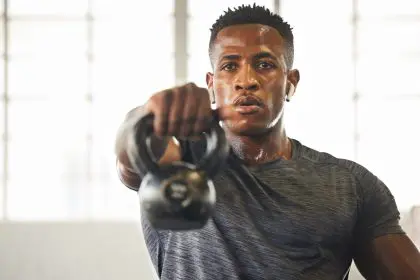The kettlebell swing stands as one of the most effective exercises for simultaneously burning fat and building lean muscle throughout the entire body. This explosive movement combines cardiovascular conditioning with strength training, creating a metabolic demand that continues burning calories long after your workout ends. The swing’s unique hip-hinge movement pattern targets multiple muscle groups while developing functional strength and power.
Unlike traditional cardio exercises that primarily burn calories during the activity, kettlebell swings create an afterburn effect that elevates metabolism for hours following your workout. The explosive nature of the movement recruits fast-twitch muscle fibers, promoting lean muscle development while the continuous motion provides intense cardiovascular benefits.
Understanding proper swing mechanics and progression allows you to maximize both fat-burning and muscle-building benefits while minimizing injury risk. These dynamic movements work by creating high-intensity intervals that challenge your anaerobic and aerobic energy systems simultaneously, leading to rapid improvements in body composition and overall fitness.
The science behind kettlebell swing effectiveness
Kettlebell swings activate the posterior chain muscles including the glutes, hamstrings, and erector spinae while engaging the core, shoulders, and arms for stabilization. This full-body activation creates a massive caloric demand that far exceeds traditional cardio exercises while building functional strength throughout multiple muscle groups.
The ballistic nature of swing movements promotes the development of explosive power and athletic performance while improving cardiovascular fitness. The rapid acceleration and deceleration phases of each swing create unique training stimuli that develop both strength and endurance simultaneously.
The metabolic impact of kettlebell swings extends beyond the workout itself, with elevated metabolism lasting 24-48 hours post-exercise. This extended calorie burn, combined with the muscle-building effects of the resistance component, makes swings particularly effective for body composition changes.
1. Traditional two-handed swing
The foundation of all kettlebell work begins with mastering the basic two-handed swing. Stand with feet shoulder-width apart, gripping the kettlebell handle with both hands. Initiate the movement by hinging at the hips and driving them back while maintaining a neutral spine and slight knee bend.
Explosively drive your hips forward to propel the kettlebell upward, allowing momentum to carry it to chest height. The power comes from hip extension, not arm lifting. Control the descent by allowing the kettlebell to swing back between your legs while hinging at the hips again.
This fundamental movement targets the glutes, hamstrings, and core while providing intense cardiovascular conditioning. Master this technique before progressing to more advanced variations, as proper hip-hinge mechanics form the foundation of all effective swing patterns.
2. Single-arm alternating swings
Progress to single-arm swings by gripping the kettlebell with one hand and performing the same hip-hinge movement pattern. The unilateral load challenges your core stability and anti-rotation strength while maintaining the same explosive hip drive that characterizes effective swings.
Switch hands at the top of each swing or perform sets with each arm individually. The single-arm variation requires greater core engagement and challenges your balance and coordination while targeting the same muscle groups as the two-handed version.
This variation burns more calories than the basic swing due to increased stability demands and allows you to work each side of your body independently. The rotational challenge also engages the obliques and deep core muscles more intensely than bilateral swings.
3. American-style overhead swings
Extend the swing arc by driving the kettlebell overhead rather than stopping at chest height. This variation requires greater shoulder mobility and core strength while increasing the cardiovascular demand and calorie burn of each repetition.
Maintain the same explosive hip drive while allowing the momentum to carry the kettlebell to full overhead extension. Control the descent through the same pathway, maintaining shoulder stability throughout the movement. This variation requires excellent shoulder mobility and thorough warm-up.
The overhead position increases the range of motion and work performed in each repetition, leading to greater calorie burn and more comprehensive muscle engagement. This variation also challenges shoulder stability and core strength throughout the extended range of motion.
4. Swing to squat combinations
Combine the swing with a squat by catching the kettlebell at chest height and immediately dropping into a goblet squat position. This combination movement increases the lower body strength component while maintaining the cardiovascular benefits of continuous motion.
After completing the squat, explosively drive up and immediately transition back into the swing motion. This creates a seamless flow between movements while targeting both the posterior chain through the swing and the quadriceps through the squat component.
The combination approach increases the total work performed and muscle groups targeted in each repetition, leading to greater calorie burn and more comprehensive muscle development. This variation also improves movement coordination and functional strength patterns.
5. High-intensity swing intervals
Structure your swing sessions as high-intensity intervals by performing maximum effort swings for 20-30 seconds followed by 30-60 seconds of rest. This approach maximizes both the fat-burning and muscle-building benefits by creating intense metabolic demands.
During work intervals, focus on maintaining explosive hip drive and proper form while maximizing repetition count. The high-intensity approach recruits more muscle fibers and creates greater metabolic disturbance than steady-state swing sessions.
Perform 6-10 intervals depending on your fitness level, maintaining maximum effort during work periods. This interval structure creates significant afterburn effect while building both anaerobic power and aerobic conditioning simultaneously.
6. Double kettlebell swings
Advanced practitioners can progress to using two kettlebells simultaneously, holding one in each hand while performing the same hip-hinge movement pattern. This variation doubles the resistance while requiring greater core stability and coordination.
The double kettlebell swing creates intense full-body muscle activation while significantly increasing the cardiovascular demand. This variation burns more calories per repetition and builds more muscle due to the increased resistance and stability demands.
Start with lighter weights when first attempting double swings, as the coordination and strength demands are significantly higher than single kettlebell variations. Focus on maintaining synchronized movement patterns and proper hip-hinge mechanics throughout each repetition.
7. Swing to clean progression
Combine the swing with a clean movement by redirecting the kettlebell’s momentum to bring it to the rack position at shoulder height. This progression adds an upper body strength component while maintaining the explosive hip drive that characterizes effective swings.
The clean component requires timing and coordination to redirect the kettlebell’s momentum smoothly, engaging the forearms, biceps, and upper back more intensely than basic swings. This variation provides more comprehensive upper body development while maintaining lower body benefits.
Practice the clean component separately before combining it with swings, as the timing and coordination requirements are more complex than basic swing variations. This progression represents an advanced movement that significantly increases the total body challenge.
Proper form and safety considerations
Maintain a neutral spine throughout all swing variations, avoiding rounding of the lower back during the bottom position. The movement should originate from hip flexion and extension rather than spinal flexion, protecting your lower back while maximizing muscle activation.
Keep the kettlebell close to your body during the swing arc, avoiding excessive forward drift that can strain the shoulders and reduce movement efficiency. The kettlebell should follow a pendulum-like arc centered around your hip joint.
Focus on controlled breathing throughout swing sessions, exhaling forcefully during the explosive hip drive phase and inhaling during the descent. Proper breathing supports core stability and helps maintain consistent power output throughout your workout.
Programming for maximum results
Structure your kettlebell swing workouts to include 2-3 different variations per session, allowing for progressive overload and continued adaptation. Begin with basic two-handed swings before progressing to more complex variations as your technique and conditioning improve.
Vary your workout structure between longer, moderate-intensity sessions and shorter, high-intensity interval protocols. This variation ensures comprehensive fitness development while preventing adaptation and maintaining progress toward your body composition goals.
Plan 3-4 swing sessions per week with at least one day of recovery between sessions. The high-intensity nature of effective swing workouts requires adequate recovery time for muscle repair and adaptation while maintaining consistent training frequency for optimal results.
Weight selection and progression
Choose kettlebell weights that allow you to maintain proper form throughout your planned workout duration while providing appropriate challenge. Men typically start with 35-53 pound kettlebells, while women often begin with 18-35 pound weights, adjusting based on individual strength levels.
Progress by increasing workout duration, repetition count, or kettlebell weight as your fitness improves. Weight increases should be gradual, typically 8-10 pounds at a time, ensuring you can maintain proper form with the heavier resistance.
Consider having multiple kettlebell weights available to allow for different exercises and progression over time. Different swing variations may require different weights based on their complexity and the muscle groups emphasized.
Creating effective workout routines
Design comprehensive workouts by combining different swing variations with appropriate work-to-rest ratios based on your fitness goals. Fat-burning sessions might emphasize longer work periods with shorter rest, while muscle-building sessions might use heavier weights with longer recovery periods.
Include adequate warm-up time focusing on hip mobility and activation exercises before beginning swing sessions. The explosive nature of swings requires proper preparation to prevent injury and ensure optimal performance throughout your workout.
Cool down with static stretching focusing on the hip flexors, hamstrings, and shoulders after swing sessions. These areas tend to tighten with regular swing training and benefit from targeted stretching to maintain mobility and prevent imbalances.
Tracking progress and results
Monitor your progress through objective measures such as total swing count, workout duration, or kettlebell weight used. These metrics provide concrete evidence of improvement and help guide workout progression over time.
Pay attention to subjective measures such as energy levels, recovery time between sessions, and overall strength in daily activities. These indicators often reflect the functional benefits of kettlebell training that extend beyond the gym environment.
Track body composition changes through measurements, photos, or how clothes fit rather than relying solely on scale weight. Kettlebell training often leads to simultaneous muscle gain and fat loss, which may not be reflected in total body weight changes.
Common mistakes and corrections
Avoid using arm strength to lift the kettlebell rather than explosive hip drive. The swing should be powered primarily by hip extension, with the arms serving only to guide the kettlebell’s path. Focus on keeping your arms relaxed and allowing hip power to drive the movement.
Prevent knee-dominant movement patterns by emphasizing the hip hinge rather than squatting motion. The knees should bend slightly, but the primary movement should occur at the hip joint to properly target the posterior chain muscles.
Maintain consistent swing height and rhythm throughout your sets rather than allowing fatigue to compromise form. Reduce weight or take longer rest periods if you cannot maintain proper technique, as poor form reduces effectiveness and increases injury risk.
Maximizing fat loss and muscle building
Combine kettlebell swing sessions with appropriate nutrition to support your body composition goals. The high calorie burn and muscle-building effects of swing training require adequate protein intake for muscle repair and appropriate total calorie intake for fat loss goals.
Consider the timing of your swing workouts relative to other training and daily activities. The high-intensity nature of effective swing sessions can be demanding on your recovery capacity, so plan accordingly to maintain consistent performance.
Supplement swing training with adequate sleep and stress management, as these factors significantly impact both fat loss and muscle building outcomes. The metabolic demands of intense swing training require comprehensive recovery support for optimal results.
Long-term development and mastery
Progress systematically through swing variations, mastering each movement before advancing to more complex patterns. This approach ensures proper movement foundation while maintaining consistent challenge and progression over time.
Consider working with qualified instruction when first learning swing techniques, as proper form is crucial for both safety and effectiveness. Video analysis or in-person coaching can help identify and correct technique issues that might limit your progress.
Set long-term goals for your swing training, such as completing specific workout challenges or achieving certain strength milestones. These goals provide motivation and direction for your training while encouraging consistent progression in your kettlebell skills and fitness development.















